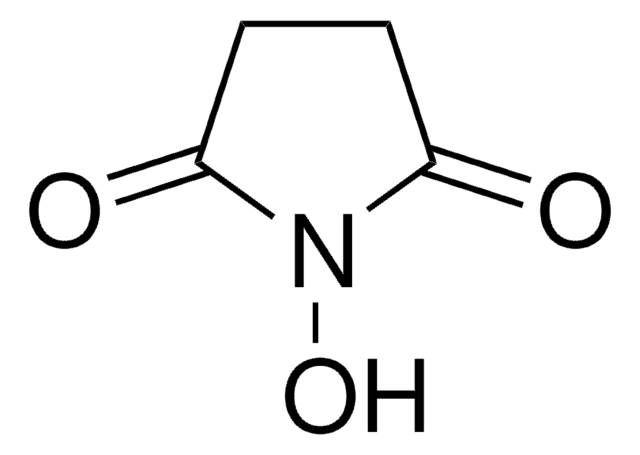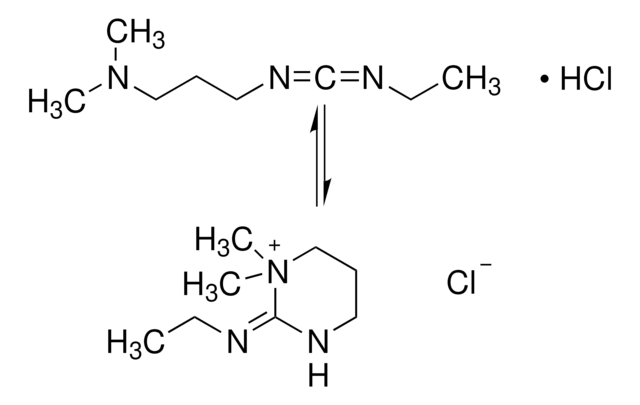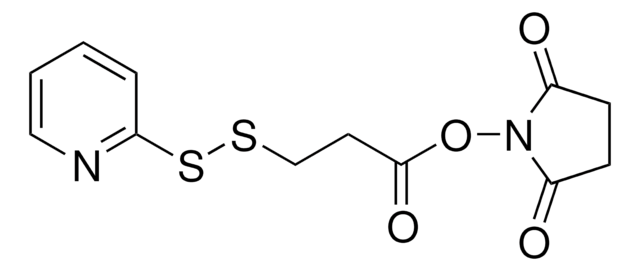803472
SMPT (4-succinimidyloxycarbonyl-alpha-methyl-alpha(2-pyridyldithio)toluene)
Synonym(s):
2,5-Dioxo-1-pyrrolidinyl 4-[1-(2-pyridinyldithio)ethyl]benzoate, SMPT
About This Item
Recommended Products
Assay
≥90%
Quality Level
form
powder
mol wt
388.46
reaction suitability
reagent type: cross-linking reagent
storage condition
desiccated
solubility
DMSO or DMF: soluble
functional group
NHS ester
shipped in
ambient
storage temp.
2-8°C
SMILES string
O=C(ON1C(CCC1=O)=O)C2=CC=C(C(SSC3=CC=CC=N3)C)C=C2
InChI
1S/C18H16N2O4S2/c1-12(25-26-15-4-2-3-11-19-15)13-5-7-14(8-6-13)18(23)24-20-16(21)9-10-17(20)22/h2-8,11-12H,9-10H2,1H3
InChI key
GKSPIZSKQWTXQG-UHFFFAOYSA-N
Related Categories
General description
Features and Benefits
- Reactive groups: NHS ester and pyridyldithiol
- Reactive towards: amino and sulfhydryl groups
- Cleavable with disulfide reducing agents
- Water-insoluble (dissolve first in DMF or DMSO)
- Contains a hindered disulfide bond; has formed immunotoxins with improved stability
- In vitro, an SMPT conjugate was as effective as conjugates formed with SPDP and 2-IT
- Compare to other varieties of SPDP-type reagents, including pegylated forms
Caution
Storage Class Code
11 - Combustible Solids
WGK
WGK 3
Flash Point(F)
Not applicable
Flash Point(C)
Not applicable
Regulatory Information
Choose from one of the most recent versions:
Certificates of Analysis (COA)
Sorry, we don't have COAs for this product available online at this time.
If you need assistance, please contact Customer Support.
Already Own This Product?
Find documentation for the products that you have recently purchased in the Document Library.
Our team of scientists has experience in all areas of research including Life Science, Material Science, Chemical Synthesis, Chromatography, Analytical and many others.
Contact Technical Service
![LC-SPDP (succinimidyl 6-[3(2-pyridyldithio)propionamido]hexanoate)](/deepweb/assets/sigmaaldrich/product/structures/300/586/d95fd80c-e201-4b0b-8aee-31e109c2ff41/640/d95fd80c-e201-4b0b-8aee-31e109c2ff41.png)





![Sulfo-LC-SPDP (sulfosuccinimidyl 6-[3′-(2-pyridyldithio)propionamido]hexanoate)](/deepweb/assets/sigmaaldrich/product/structures/266/633/e2a263be-4bd3-4fcf-89c4-75b5e2bd829c/640/e2a263be-4bd3-4fcf-89c4-75b5e2bd829c.png)
